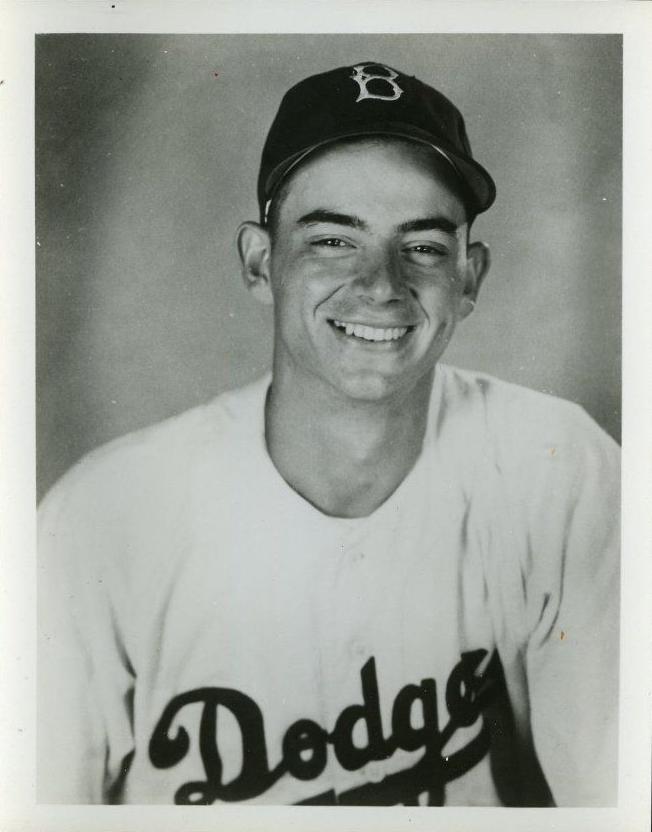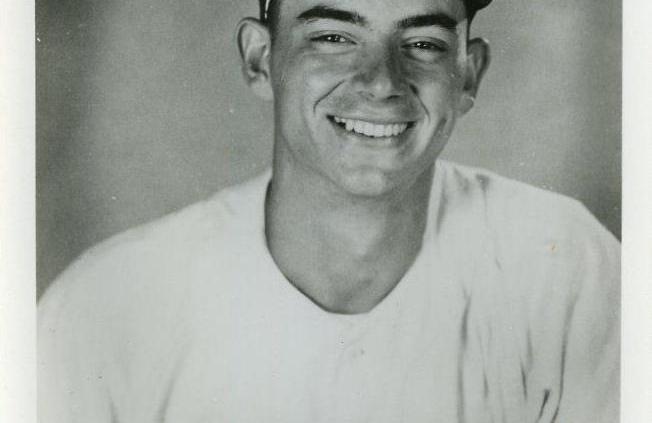August 3, 1944: Tommy Brown debuts for Dodgers as a 16-year-old shortstop
 Leo Durocher, manager of the eighth-place Brooklyn Dodgers, refused to accept excuses from his new shortstop, Tommy Brown. Brown arrived at Ebbets Field fresh off an all-night train ride that brought him to the big leagues from the Newport News Dodgers of the Class-B Piedmont League.
Leo Durocher, manager of the eighth-place Brooklyn Dodgers, refused to accept excuses from his new shortstop, Tommy Brown. Brown arrived at Ebbets Field fresh off an all-night train ride that brought him to the big leagues from the Newport News Dodgers of the Class-B Piedmont League.
Thinking a 16-year-old shortstop would make a difference for the Dodgers seemed a stretch. The Dodgers’ on-field product was decimated with many key players, including regular shortstop Pee Wee Reese, having answered the call of the military for service in World War II. Reese, who joined the US Navy after the 1942 season, left a hole in the middle of the infield.1
General manager Branch Rickey and Durocher tested 26-year-old Bobby Bragan’s skills at shortstop in Reese’s absence. Bragan instead demonstrated his lead legs and lack of mobility.2 Brooklyn’s brain trust remembered Brown, whom Durocher had sarcastically nicknamed “Buckshot,” from spring training earlier in the year.3
“I don’t think Leo Durocher will use you for a couple of days at least,” Rickey said, attempting to settle the teenager’s nerves. “However, he’s the manager of the team and don’t be surprised if he decides to play you sooner than expected.”4
Thanks to rain one week earlier, the Dodgers had a doubleheader lined up against the Chicago Cubs on August 3, 1944. Durocher did not hesitate to insert Brown, one of the youngest infielders ever to make a major-league roster, into the Dodgers’ starting lineup for the first game of the twin bill.5 With a record of 38-59, the Dodgers had nothing to lose except sole possession of the National League’s cellar.
Brown was the product of an unconventional upbringing in Brooklyn’s Bensonhurst neighborhood. He never knew his father and the youngster’s aunt and uncle served as guardians during his formative years.6 By the time he turned 12 years old, Brown left school to earn an honest wage alongside his uncle unloading barges on New York’s docks.7 When the youngster was not working the docks, he passed his time playing baseball on Brooklyn’s cobblestone streets or on one of the borough’s Kiwanis club teams.8
In 1943 one of Brown’s friends persuaded him to participate in the Dodgers’ open tryouts with 2,500 other aspiring ballplayers at the Parade Grounds. An avid Dodgers fan, Brown attended the tryouts without his own spikes or glove, but survived the three-day workout. Team management assured Brown that his performance distinguished himself from the others and he would rank among the handful of players who would hear from the team at a later date.9 That winter, Brown received news that he should report to the Dodgers’ spring-training camp at Bear Mountain, New York.10
After spring training the Dodgers assigned Brown to the franchise’s farm team in Newport News, Virginia. By the end of July 1944, he had 91 minor-league games under his belt.11 Brown was batting just shy of .300 and pacing the Piedmont League with 11 triples when he received news that the Dodgers expected him to report to Ebbets Field. Reluctant to leave a situation in which he excelled, Brown informed his manager, Jake Pitler, that he was not interested.12 Despite the protest, Pitler said, “No, you’ve got to leave now.”13 He made sure Brown packed and boarded a train headed for Brooklyn.
Heavy rains drenched Ebbets Field and its 6,146 spectators just minutes prior to the game, but the inclement weather would not wash away Brown’s debut.14 During pregame warmups, Durocher noted Brown’s erratic defense and wildness. After fielding groundballs, the young shortstop consistently missed his mark and heaved the ball beyond first baseman Howie Schultz’s glove.15 Durocher shook his head and remembered the nickname, “Buckshot,” that he gave to Brown during spring training.16 Once the game started, Brown fielded his position and watched as Chicago’s Dom Dallessandro belted a two-run homer in the top of the first inning giving the Cubs a 3-0 lead.
Brown’s first trip to the plate came in the bottom of the second inning against the Cubs starting pitcher, Bob Chipman. Eddie Stanky singled with one out and stood on first base. Brown reached first safely after grounding into a fielder’s choice. Pitcher Curt Davis ended the inning on a fly ball to Bill Nicholson in right field.
Cubs third baseman Stan Hack challenged Brown’s defense leading off the third inning. Brown misjudged Hack’s high bounder, the ball rolled up his arm, and by the time he secured the ball, his throw was too low and too tardy.17 The runner was safely on first base.18 The young shortstop found vindication as Hack attempted to swipe second base. With Phil Cavarretta at the plate, catcher Bragan fired a strike to Brown, who applied the tag on Hack.
Brown’s nervousness continued as the Cubs held a 5-0 lead in the top of the fourth inning.19 With two outs and Mickey Kreitner on first, Chipman tapped an easy groundball to short. Brown allowed the grounder to trickle through his legs; he was charged with an error. The youngster dodged a bullet when Hack squashed the Cubs’ rally with a groundout to first base.
With Brooklyn still trailing 5-0, Schultz started the Dodgers’ fourth inning with a double. Bragan and Stanky failed to bring him home. Brown found himself batting with a runner in scoring position. He popped up to third baseman Hack, who ranged into foul territory to retire the side.
With two outs and the bases empty in the top of the seventh inning, Brown steadied his nerves in the field. He cleanly gloved shortstop Roy Hughes’ grounder and fired a strike across the infield to Schultz, retiring the side.
The Cubs maintained their comfortable five-run lead heading into the home half of the seventh. Brown stepped to the plate with no outs and an opportunity for damage. Stanky, who had led off the inning with a walk, stood on first base. Brown smashed a Chipman pitch into left-center field, but Stanky applied the brakes at third and the rookie stopped at second with a double. The kid from Brooklyn notched his first major-league base hit. Just as they had been doing since Brown took the field at the start of the game, the Dodgers fans applauded the feat.20
With Stanky at third and Brown at second, Mickey Owen entered the game as a pinch-hitter for the pitcher Davis. Owen hit a fly ball to Dallessandro in left field and sent Stanky racing home to put Brooklyn on the scoreboard. Frenchy Bordagaray, the Dodgers’ center fielder, grounded a pitch back to Chipman, but first baseman Cavarretta made a wild throw to third base and was charged with an error.21 Brown took advantage of the miscue, rounded third and charged home. Within moments, his inaugural base hit resulted in his first run and trimmed the Cubs’ lead to 5-2.
In the top of the eighth inning, the Cubs added an extra run to extend their lead to 6-2. In the home half of the frame, Bragan singled with one out. Hoping to start a late rally, Durocher sent Paul “Big Poison” Waner in to pinch-hit for Stanky. He promptly popped out to Dallessandro in foul territory. The crowd began to rumble as Brown returned to the plate, but he hit a grounder to Hack at third base, who hurled the ball across the field and ended the inning.
Both teams hung zeroes on the scoreboard in the ninth inning. Brown did not get another opportunity to hit or drive in a run, but the 16-year-old shortstop finished his first major-league game batting 1-for-4. He ended with a double, one run scored, and an error. Neither Brown nor his teammates had much time to celebrate as the second game of the doubleheader was about to start.
SOURCES
In addition to the sources cited in the Notes, the author accessed Retrosheet.org, Baseball-Reference.com, and SABR.org.
Photo credit: Tommy Brown, Trading Card Database.
NOTES
1 C. Paul Rogers III, “Tommy Brown,” SABR BioProject; https://sabr.org/bioproj/person/7913ae6c.
2 Hy Turkin, “Cubs, Flock Offer Only Local Game,” New York Daily News, August 3, 1944: 36.
3 Lyle Spatz, ed., The Team That Forever Changed Baseball and America: The 1947 Brooklyn Dodgers. (Lincoln and London: University of Nebraska Press, 2012), 125.
4 Lee Scott, “Kid Plays Well as Dodgers Lose Twice,” Brooklyn Citizen, August 4, 1944.
5 Harold C. Burr, “Brown’s Major Baptism Due Against Chi Cubs,” Brooklyn Daily Eagle, August 3, 1944: 17.
6 Spatz, 125.
7 Bill Traughber, “Tommy Brown Recalls His Career,” SABRgraphs. http://www.multibriefs.com/briefs/sabr/TommyBrown.php
8 “Kiwanis Ball Project Spreads to Groups,” Brooklyn Daily Eagle, April 11, 1944: 13.
9 Spatz, 125.
10 Traughber.
11 Skip Nipper, “Nashville Volunteer Tommy Brown and His Place in Baseball History,” Baseball in Nashville, June 5, 2019. https://baseballinnashville.com/main/f/nashville-volunteer-tommy-brown-and-his-place-in-baseball-history.
12 Traughber.
13 Rogers.
14 Dick Young, “Cubs Rout Dodgers, 6-2, 7-1,” New York Daily News, August 4, 1944.
15 Young.
16 Spatz, 125.
17 Young.
18 Burr.
19 Scott.
20 Young.
21 Irving Vaughan, “Cubs Gain Fourth Place by Defeating Dodgers, 6-2, 7-1,” Chicago Tribune, August 4, 1944.
Additional Stats
Chicago Cubs 6
Brooklyn Dodgers 2
Game 1, DH
Ebbets Field
Brooklyn, NY
Box Score + PBP:
Corrections? Additions?
If you can help us improve this game story, contact us.


